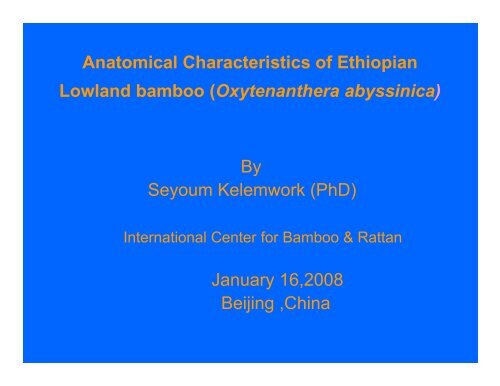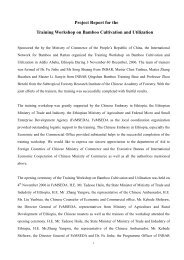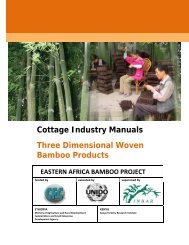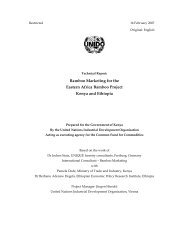Anatomical Characteristics of Ethiopian Lowland bamboo ...
Anatomical Characteristics of Ethiopian Lowland bamboo ...
Anatomical Characteristics of Ethiopian Lowland bamboo ...
Create successful ePaper yourself
Turn your PDF publications into a flip-book with our unique Google optimized e-Paper software.
<strong>Anatomical</strong> <strong>Characteristics</strong> <strong>of</strong> <strong>Ethiopian</strong><br />
<strong>Lowland</strong> <strong>bamboo</strong> (Oxytenanthera abyssinica)<br />
By<br />
Seyoum Kelemwork (PhD)<br />
International Center for Bamboo & Rattan<br />
January 16,2008<br />
Beijing ,China
Acknowledgements<br />
‣ First and foremost I would like to express my sincere<br />
gratitude and appreciation to International center for<br />
<strong>bamboo</strong> and rattan for providing me an opportunity to<br />
carry out this research.<br />
‣ A special thanks is extended to Dr. Yu Yan for his<br />
constant support throughout the research work<br />
‣ Many thanks to Mr.Tian for all his assistance at several<br />
stages <strong>of</strong> my laboratory work<br />
‣ My sincere thanks extends to Mr Honghai Dai for all his<br />
hospitality and assistance during my stay in ICBR<br />
‣ Appreciation and thanks extend for Miss Song Ye, all<br />
ICBR staff members and graduate students who helped<br />
me in all aspects during my stay in China
Potential and Utilization <strong>of</strong> Bamboo<br />
resource in Africa & Ethiopia<br />
‣ Africa possesses about 43 species <strong>of</strong> <strong>bamboo</strong><br />
under 11 genera, covering an area <strong>of</strong> over 1.5<br />
million hectares<br />
‣ The most widely distributed African <strong>bamboo</strong> is<br />
categorized under three genera: Arundinaria,<br />
Oreobambos and Oxytenanthera.<br />
‣ The greatest potential <strong>bamboo</strong> richness is in<br />
East Africa (Ethiopia,Kenya,Sudan& Ugana)<br />
‣ The highest diversity <strong>of</strong> <strong>bamboo</strong> in Africa about<br />
33 species are found in Madagascar
The Resource potential <strong>of</strong> Bamboo in<br />
Ethiopia<br />
‣ Ethiopia which is<br />
unique among<br />
African countries<br />
has over million ha<br />
<strong>of</strong> <strong>bamboo</strong><br />
resources<br />
‣ The ancient<br />
<strong>Ethiopian</strong> monarchy<br />
had a history <strong>of</strong> 3<br />
thousand years and<br />
maintained the<br />
countries freedom<br />
from colonial rule,<br />
with the exception <strong>of</strong><br />
the 1936-41 Italian<br />
occupation during<br />
World War II
Cont…<br />
‣ Ethiopia with a total<br />
land area <strong>of</strong> 112.3<br />
million hectares is<br />
located at 3ο 30’ N to<br />
15ο N latitude and <strong>of</strong><br />
330 E to 48ο E<br />
longitude in the north<br />
eastern horn <strong>of</strong> Africa<br />
‣ The country has two<br />
indigenous <strong>bamboo</strong><br />
species The highland<br />
<strong>bamboo</strong> (Arundinaria<br />
alpina K.Schumann Lin;<br />
synonym: Yushania<br />
alpina) and the<br />
monotypic genus<br />
lowland <strong>bamboo</strong><br />
Oxythenantera<br />
abyssinica (A. Richard)<br />
Munro.
Cont…<br />
‣ The <strong>Ethiopian</strong> natural<br />
<strong>bamboo</strong> forest is about<br />
1 million ha, which is<br />
about 7% <strong>of</strong> the world<br />
total and 67% <strong>of</strong> the<br />
African <strong>bamboo</strong> forest<br />
area<br />
‣ It’s very important to<br />
point out that Ethiopia is<br />
the only country in Africa<br />
which has over 850,000000<br />
ha <strong>of</strong> Oxythenantera<br />
abyssinica natural<br />
<strong>bamboo</strong> forest<br />
(Abyssinia )
‣Oxythenantera abyssinica is a clumping<br />
(sympodial) type <strong>bamboo</strong> with solid culm at<br />
maturing age. It has an average culm<br />
diameter <strong>of</strong> 5 cm, and is 7 m high<br />
‣This species grows at an elevation <strong>of</strong><br />
between 1000 to 1800 m above sea level<br />
and is widely distributed in lowland areas <strong>of</strong><br />
the country.<br />
‣It grows naturally in warm climates with<br />
average temperature <strong>of</strong> 35o C and mean<br />
annual rainfall between 900 to 1400 mm<br />
(Anonymous, 1997).<br />
‣About 85% <strong>of</strong> the total <strong>bamboo</strong> forest <strong>of</strong> the<br />
country is covered by this species
Cont…<br />
Traditionally <strong>bamboo</strong><br />
has been widely<br />
used for the<br />
construction <strong>of</strong><br />
houses, fuel, feed,<br />
fodder, beehives,<br />
hats, mats, baskets,<br />
handicrafts, small<br />
furniture and other<br />
countless products
‣ In Ethiopia, the economic<br />
potential <strong>of</strong> <strong>bamboo</strong> has not<br />
yet tbeen explored and dthe<br />
role <strong>of</strong> <strong>bamboo</strong> resources in<br />
national economies is<br />
negligible.<br />
‣ Bamboo plays an important<br />
role only in ecology and<br />
biodiversity conservation in<br />
the country.<br />
‣ Inherent natural properties <strong>of</strong><br />
<strong>bamboo</strong> such as anatomical,<br />
physical and chemical<br />
properties are not studied<br />
‣ There is lack <strong>of</strong> information<br />
to use these resource for<br />
industrial applications such<br />
as pulp p and paper p production<br />
or in any other large-scale<br />
<strong>bamboo</strong> industry<br />
Cont…
‣ Oxythenantera<br />
t<br />
abyssinica which uses<br />
for house construction<br />
for sell in the market<br />
‣ Furniture made from<br />
Yushania alpina culms
Objectives <strong>of</strong> the study<br />
The main objective <strong>of</strong> this study was<br />
‣ to investigate major anatomical characteristics <strong>of</strong><br />
Oxytenanthera abyssinica culms.<br />
Specifically this study attempts to investigate the<br />
followings:<br />
‣ -to evaluate the distribution <strong>of</strong> vascular bundles.<br />
‣ - to evaluate metaxylem e vessels s distribution<br />
‣ -to evaluate fiber sheath percentage, fiber length<br />
and fiber diameter
Material and method<br />
Sample collection<br />
‣ O.abyssinica culms used in this<br />
study are harvested from Ethiopia<br />
‣ Two, three and four year old Culms<br />
were used for this study<br />
‣ Randomly selected culms were cut<br />
at 30 cm height above ground level<br />
and the merchantable length <strong>of</strong> culm<br />
was fixed at 6m length<br />
‣ The stem <strong>of</strong> each culm was marked<br />
and cut at about 2 m, into three<br />
equal portions (bottom,middle and<br />
top)<br />
‣ The 2nd internodes from the bottom<br />
‣ The 2nd internodes from the bottom<br />
side <strong>of</strong> each portion were chosen for<br />
this experiment
Cont…<br />
Sample preparation<br />
Specimens <strong>of</strong> <strong>bamboo</strong> splits <strong>of</strong> 3 cm length had been<br />
prepared from<br />
‣ three age groups (2, 3 & 4 year-old)<br />
‣ three portions (bottom ,middle & top)<br />
‣ three culm wall layer ( Inner ,middle & outer)<br />
to evaluate basic anatomical parameters<br />
Leica light microscope with the magnification <strong>of</strong> 5x<br />
was used for<br />
‣ vascular bundles distribution<br />
‣ percentage fiber sheath<br />
‣ percent <strong>of</strong> metaxylem vessels and<br />
‣ radial/ tangential ration measurements.<br />
Four fields with an area <strong>of</strong> 2174641 µm2 were<br />
observed in each section.
Cont…<br />
For<br />
‣ Fiber length<br />
‣ Fiber diameter and<br />
‣ Fiber wall thickness<br />
about 1-2 cm length were macerated in a solution <strong>of</strong><br />
50% acetic acid and 50% hydrogen peroxide<br />
From<br />
‣ Each age –group<br />
‣ Each culm portion and<br />
‣ Each culm layer<br />
‣ A total <strong>of</strong> 945 randomly selected fibers were<br />
measured using Leica light microscope
Result and Discussion<br />
The vascular bundles<br />
<strong>of</strong> O.abyssinica was<br />
examined ed and<br />
classified according<br />
to the classification<br />
<strong>of</strong> vascular bundles<br />
by Grossert and<br />
Liese (1971).<br />
O.abyssinica may<br />
be categorized<br />
under type III,<br />
consisting <strong>of</strong> two<br />
parts central<br />
vascular strand and<br />
one fiber strand
Cont…<br />
‣ The vascular bundles<br />
<strong>of</strong> O.abyssinica<br />
are<br />
formed by two large<br />
metaxylem vessels<br />
two protoxylem<br />
elements, the<br />
phloem, the<br />
sclenrenchyma<br />
sheath and fiber<br />
sheath<br />
‣ vascular bundles<br />
have significant<br />
variations among<br />
the, culm height and<br />
across the culm wall<br />
thickness and have<br />
no variation among<br />
age-groups.
vascular a bundles distribution across culm wall thickness<br />
‣ Across the culm layer vascular<br />
bundles distribution changes<br />
consistently from outer layer<br />
towards the inner layer <strong>of</strong> the<br />
culm<br />
‣ The highest distribution across<br />
140<br />
the culm wall layer was<br />
120<br />
observed in the outer layer <strong>of</strong> 3<br />
and 4 year-old culms (about<br />
100<br />
183 bundles/cm2) followed in<br />
80<br />
middle layer <strong>of</strong> the same age<br />
which has about 149 60<br />
bundles/cm2.<br />
‣ The lowest distribution was<br />
found in the inner layer <strong>of</strong> 2<br />
year-old culms (about 80<br />
bundles/cm2).<br />
•<br />
2 )<br />
t io n ( bundles/cm 2<br />
bundles distribut<br />
V ascular<br />
200<br />
180<br />
160<br />
40<br />
20<br />
0<br />
Vascualr bundlesmdistribution across the culm layer<br />
bottom middle top<br />
Inner middle outer<br />
Culm wall layer
vascular distribution <strong>of</strong> bundles anong the culms height<br />
‣ The distribution <strong>of</strong><br />
vascular bundles<br />
varied widely along<br />
the culm’s height<br />
Vascular bundles along the culm height<br />
age 2 age3 age4<br />
200<br />
s/cm 2 )<br />
Vascular bundles distribution (bundle<br />
180<br />
160<br />
140<br />
120<br />
100<br />
80<br />
60<br />
40<br />
20<br />
The heights distribution<br />
was observed in the top<br />
portion <strong>of</strong> 4 year-old and<br />
the lowest was found in<br />
bottom portion <strong>of</strong> 2 years<br />
old culms<br />
0<br />
bottom middle top<br />
culm portion
Radial and Tangential Ratio <strong>of</strong> vascular bundles<br />
‣ The shape and size <strong>of</strong><br />
vascular bundle was<br />
measured in two<br />
directions as radial and<br />
tangential<br />
3<br />
Radial /Tangential Ratio<br />
age 2 age3 age4<br />
‣ The result <strong>of</strong><br />
radial/tangential ratio<br />
shows that a vascular<br />
bundle size varies across<br />
the culm wall layer.<br />
‣ No variation was<br />
observed along the culm<br />
height and among agesgroups.<br />
‣ They are larger in the<br />
middle layers than inner<br />
and outer layers<br />
2.5<br />
R a d ia l/ T a n g e<br />
n t ia l R a t io<br />
2<br />
1.5<br />
1<br />
0.5<br />
0<br />
inner middle outer<br />
Culm layer
Percentage <strong>of</strong> Metaxylem vessels<br />
• The metaxylem <strong>of</strong><br />
O.abyssinica consists <strong>of</strong><br />
two large vessels<br />
separated by<br />
parenchyma and serve<br />
for water transport<br />
• The percentage <strong>of</strong><br />
metaxylem vessels<br />
varied widely among<br />
culm’s <strong>of</strong> different age –<br />
groups and height<br />
• No variation across the<br />
culm walls thickness.
Percent <strong>of</strong> metaxylem vessels along height & age-groups<br />
‣ High percent <strong>of</strong><br />
metaxylem vessels are<br />
7<br />
found in younger culms<br />
than older<br />
6<br />
‣ The highest percentage<br />
was observed in the top<br />
5<br />
portion <strong>of</strong> 3 year-old<br />
culms ( about 6.3%)<br />
4<br />
‣ The lowest was found in<br />
bottom portion <strong>of</strong> 4 yearold<br />
culms (about 1% ).<br />
‣ Regardless <strong>of</strong> <strong>bamboo</strong><br />
age and culm portion the<br />
percentage <strong>of</strong><br />
metaxylem vessels<br />
obtained in this<br />
experiment falls within<br />
the rage <strong>of</strong> 1 to 6.3<br />
percent<br />
er ce nt 3P a ge <strong>of</strong> M etaxylem<br />
2<br />
1<br />
0<br />
Percentage <strong>of</strong> Metaxylem vessels<br />
bottom middle top<br />
age 2 age3 age4<br />
Bamboo Age
• Fibbers are mechanical tissues<br />
and their principal function is<br />
essentially to impart strength to<br />
the culm<br />
• The region with more density in<br />
the vascular bundles is called<br />
fiber sheath and contains<br />
cellulose micro-fibers, which are<br />
responsible for the <strong>bamboo</strong><br />
strength.<br />
Fiber sheath Percentage<br />
• The relative area <strong>of</strong> sheaths in<br />
O.abyssinica a vascular bundle<br />
varies among the culm age and<br />
on the position culm’s wall<br />
thickness<br />
• The fiber sheath percentage<br />
The fiber sheath percentage<br />
along the culm;s height showed<br />
inconsistent variation
Fiber sheath percentage among the age-groups<br />
‣ Fiber sheath percentage<br />
increases from the<br />
30<br />
younger culms towards<br />
the old culms in the<br />
25<br />
middle layers <strong>of</strong> all age –<br />
groups<br />
20<br />
‣ The fibre sheath<br />
coverage observed at the 15<br />
top portion <strong>of</strong> 4 year-old<br />
culms was about 28%)<br />
10<br />
‣ At bottom portion <strong>of</strong> 2<br />
5<br />
year-old culms about<br />
12%) coverage was<br />
0<br />
observed<br />
Fiber sh heath(% )<br />
Fiber sheath Percentage<br />
bottom middle top<br />
age 2 age3 age4<br />
Bamboo age
Fiber sheath percentage across the wall thickness<br />
‣ Highest percentage <strong>of</strong><br />
fiber sheath was<br />
observed in bottom<br />
45<br />
portion <strong>of</strong> 4 year-old<br />
40<br />
outer layer <strong>of</strong> the culm<br />
wall (40%) than those in<br />
35<br />
middle and inner layers<br />
30<br />
( 30% and 29%<br />
respectively) 25<br />
‣ Regardless <strong>of</strong> age, culm<br />
portion and culm wall<br />
thickness, fiber sheath<br />
percentage obtained in<br />
this experiment falls<br />
within the rage <strong>of</strong> 12 to 40<br />
percent.<br />
F ib e r s h e<br />
a t h ( % )<br />
20<br />
15<br />
10<br />
5<br />
0<br />
Fiber sheath across the culm wall layer<br />
bottom middle top<br />
inner middle outer<br />
Culm wall layers
Fiber length, fiber width and wall thicknesses<br />
‣ The fibers in the<br />
culms <strong>of</strong> O.abyssinica<br />
around vascular<br />
bundles formed a fiber<br />
sheath or fiber cap.<br />
They are long tapered<br />
at both ends<br />
‣ Fiber measurements<br />
results indicated that<br />
O.abyssinica fibers<br />
length differ with age,<br />
culm portion and culm<br />
wall thickness
Fiber length <strong>of</strong> O.abyssinica culms<br />
• The fiber length is increases<br />
with increase <strong>of</strong> age<br />
3000<br />
Effect <strong>of</strong> age on fiber length<br />
bottom middle top<br />
‣ The longer fiber length was<br />
observed in the bottom portion<br />
<strong>of</strong> 4 year-old culms<br />
(3088.21µm) and the shorter<br />
was found in top portion <strong>of</strong> 2<br />
year –old culms( 1817 µm)<br />
‣ Fiber length decreases with<br />
increase <strong>of</strong> culm portion.<br />
Fiber length(µm)<br />
2500<br />
2000<br />
1500<br />
1000<br />
500<br />
0<br />
‣ Regardless <strong>of</strong> <strong>bamboo</strong> age<br />
and culm portion the fiber<br />
length obtained in this<br />
experiment falls within the<br />
rage <strong>of</strong> 1817 to 3088 µm.<br />
age-2<br />
age-<br />
3<br />
Bamboo age<br />
age-4
Fiber diameter and fiber wall thickness<br />
‣ The results indicated that the fiber<br />
wall underwent low thickening<br />
20<br />
from 2 to 4 years growth rate.<br />
bottom middle top<br />
Fiber diameter<br />
‣ The thicker fiber width was<br />
observed in bottom portion <strong>of</strong> 4<br />
year-old culms (about 18.77 µm)<br />
‣ Thinner was found in top portion<br />
<strong>of</strong> 2 year-old culms ( about 13.11<br />
µm)<br />
‣ Fiber width showed decreasing<br />
trend from bottom towards top<br />
portion.<br />
‣ Inconsistent variation observed<br />
across the wall thickness .<br />
‣ Regardless <strong>of</strong> age, height and<br />
culm wall thickness the fiber<br />
diameter observed in this<br />
experiment ranges from 12.77 to<br />
18.77 µm.<br />
18<br />
16<br />
14<br />
12<br />
10<br />
8<br />
6<br />
4<br />
2<br />
0<br />
age 2 age3 age4<br />
Bamboo age
Fiber wall thickness<br />
‣ Increases with increases <strong>of</strong><br />
age<br />
7<br />
‣ Thicker wall thickness was<br />
6<br />
observed in bottom portion <strong>of</strong><br />
4 year-old (about 6.44 µm)<br />
5<br />
‣ Thinner found in top portion <strong>of</strong><br />
4<br />
2 year-old culms (about 4.13<br />
µm)<br />
‣ Decreasing from basal<br />
2<br />
towards the top portion<br />
‣ Across the wall thickness the<br />
fiber wall are thin in the inner<br />
0<br />
layer than middle and outer<br />
layers.<br />
‣ Regardless <strong>of</strong> age, height and<br />
wall thickness the fiber wall<br />
thickness observed in this<br />
experiment ranges from 3.84<br />
to 6.76 µm.<br />
3wall thickness (µm)<br />
1Fiber<br />
Fiber wall thickness<br />
bottom middle top<br />
age 2 age3 age4<br />
Bamboo age
Conclusion<br />
Based on the results <strong>of</strong> this study, the following conclusion<br />
may be drawn.<br />
‣ Bottom and middle portion <strong>of</strong> 3 and 4 year-old<br />
O.abyssinica culms with less vascular bundles<br />
distribution can be used for <strong>bamboo</strong>-based board’s<br />
applications such as particleboards, medium density<br />
fiber board and strand boards and<br />
for pulp and paper<br />
manufacture<br />
‣ The upper part consists mainly <strong>of</strong> many smaller vascular<br />
bundles with a high proportion <strong>of</strong> fibers can be used for<br />
for pulp and paper manufacture, toothpick, match-stick<br />
stick,<br />
incense-sticks, scaffolding sleepers and charcoal<br />
production
Thank you very much







